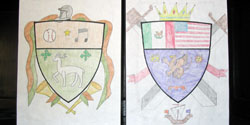 Assessing Projects : Using Assessment to Improve Teaching and Learning
Assessing Projects : Using Assessment to Improve Teaching and Learning Intermediate Phase Assessment Plans | Senior / FET Phase Assessment Plans

Medieval Times
At a Glance
|
Grade Level: 6-8
Subject: Social Science Topics: World History, Medieval European Life Higher-Order Thinking Skills: Decision Making, Creativity Key Learnings: Feudalism, Medieval Life, Ancient Architecture Time Needed: 3-4 weeks, 3-4 hours per week, 45 minutes per class |
Things You Need
Assessing Projects (CD)
Assessing Projects* (online)
Project Summary
Medieval life comes alive in this social science classroom as learners examine the life and times of people from this historical period. All learners wrestle with the Essential Question, Can we really be whatever we want to be? and in this project they explore this question from their own perspective as well as from the perspective of people living during medieval times. After conducting extensive research about medieval life, and answering questions such as, How did one’s role in medieval times influence their daily life?, What resources were available to a person living in medieval society? and, How was the power structure organized among various people in medieval society?, learners select a medieval role to research further and then create a role-play performance for the class. All learners experience an authentic feel of medieval life in regards to food, shelter, and heraldry by creating their own menu of medieval foods, building their dream castle, and creating a personal coat of arms based on the research they’ve gathered. To close the project, learners write an essay to connect their learning to their own life by revisiting the Focus Question, How is medieval life different from yours?
Curriculum-Framing Questions
- Essential Question
Can we really be whatever we want to be? - Focus Question
How is medieval life different from yours?
How did one’s role in medieval times influence their daily life?
How does form follow function in medieval castles? - Content Questions
What resources were available to a person living in medieval society?
How was the power structure organized among various people in medieval society?
What were the various parts and functions of a castle in medieval society? - Brainstorming
- Discussion Checklist
- Medieval Log
- Medieval Character Oral Presentation Rubric
- Medieval Log Checklist
- Critical-Thinking Checklist
- Discussion Checklist
- Menu Scoring Guide
- Castle Building Scoring Guide
- Blueprint Peer Review
- Critical-Thinking Checklist
- Discussion Checklist
- Medieval Character Oral Presentation Rubric
- Medieval Essay Rubric
Assesement Plan
Assessment Timeline
This timeline shows in chronological order the different types of formal and informal assessments that occur during the project. The table below explains how each assessment is used and who uses it for what purpose.
Assessment Timeline |
Before project work begins |
Learners work on projects and |
After project work is completed |
|
| Assessment | Process and Purpose of Assessment |
| Brainstorming | Learners use brainstorming to access prior knowledge. Teacher uses it to gauge readiness for medieval study. |
| Medieval Log | Learners use the log to organize their ideas about medieval roles, document resources, and make connections. In the log, learners respond to teacher prompts aimed at deepening the understanding of medieval times. Learners use information from the log to create presentations and artifacts. Teacher uses the log to monitor each learner’s research progress, check for misunderstandings, and provide clarification as necessary |
| Medieval Character Oral Presentation Rubric | Learners use the rubric to effectively plan oral presentations. Teacher uses it to assess the understanding and performance of the medieval character oral presentation. |
| Medieval Log Checklist | Learners use the checklist to monitor their progress through the research process. It helps ensure that they have all the necessary research components for the project. |
| Critical-Thinking Checklist | Teacher uses this checklist to keep notes while questioning learners as they work. The checklist helps track the critical thinking learners are engaged in during the project. Teacher also uses the checklist provide feedback to learners and for assessment at the end of the project. |
| Discussion Checklist | Teacher uses the discussion checklist to observe learner, notes participation in discussions, and reviews during the project to adjust questioning as well as provide feedback. Teacher also uses it at the end of the project for final assessment. |
| Menu Scoring Guide | Learners use this scoring guide to self-assess progress on the menu. It is also used as a final assessment by the teacher. |
| Castle Building Scoring Guide | Learners use the scoring guide to self-assess success of their blueprint and castle constructions. Teacher uses it to assess how well learners understand the purpose, parts, and construction of a medieval castle. |
| Blueprint Peer Review | Learners use this peer review form to assess the quality of each other’s blueprints. This guide provides the form and function pieces already filled in so learners can compare to what is on the blueprint. Teacher uses the form to review learner’s ability to offer objective feedback and then adjusts teaching as necessary. |
| Medieval Essay Rubric | During a final class session learners are asked to respond to the Focus Question; How is medieval life different from yours? Teacher uses this rubric to assess learner’s ability to connect their learning to their own lives. |
| Credits William Brooks participated in the Intel® Teach Program, which resulted in this idea for an assessment plan. A team of teachers expanded the plan into the example you see here. |
